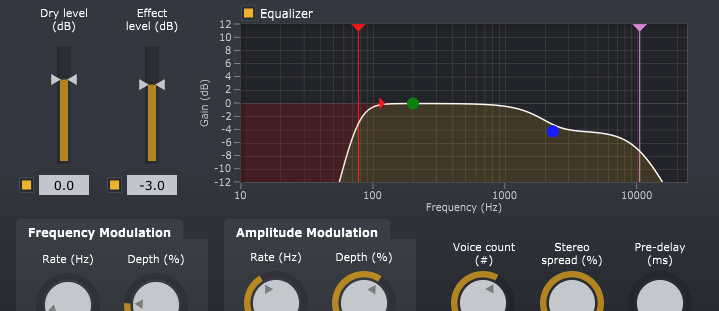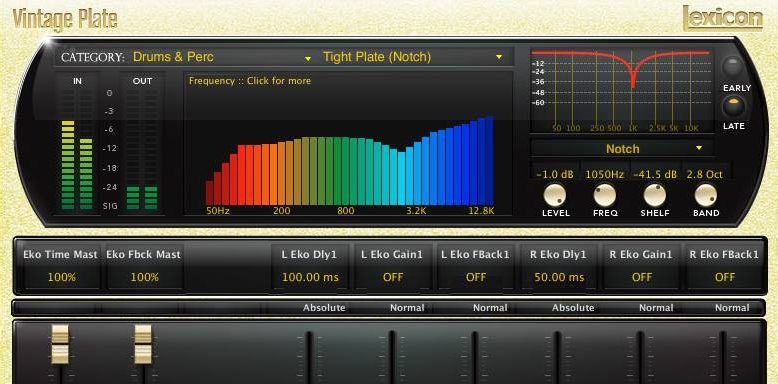
In this example, you use two implementations of graphic equalizers. Graphic equalizers provide control over the gain parameter while using standard center frequencies and common bandwidths. This leaves only one parameter to tune: filter gain. Standards like IS0 266:1997(E), ANSI S1.11-2004, and IEC 61672-1:2013 define center frequencies for octave and fractional octave filters. Octave, two-third octave, and one-third octave have emerged as common bandwidths for equalizers based on the behavior of the human ear. While parametric equalizers are useful when you want to fine-tune the frequency response, there are simpler equalizers for cases when you need fewer controls. Audio Toolbox™ provides the multibandParametricEQ System object and the Single-Band Parametric EQ block for parametric equalization. Parametric equalizers provide control over three filter parameters: center frequency, bandwidth, and gain. One of the more sophisticated equalization techniques is known as parametric equalization. They are essentially a group of filters designed to provide a custom overall frequency response. For example, they can be used to compensate for bias introduced by speakers, or to add bass to a song. S(M)exoscope.Equalizers are commonly used by audio engineers and consumers to adjust the frequency response of audio. In the course Common folder in the AuLab_Ten6_Ten7 You should hear the sound and see the plot. Delete the default text and copy, paste the following text into musc208ocataveTest.m. TextWrangler should open with a new document. At the octave prompt type: edit musc208ocataveTest.m Press, hold, and move the left mouse button to rotate the graphic. Run double click /Applications/Octave to run the program. Expand the folders to verify the files were copied into the correct folders. Choose Show Package Contents from the popup menu. Right click and hold the Octave.app icon. Save it to the Desktop as octaverc (no file extension)Ĭopy paste this command into Terminal and execute.Ĭp ~/Desktop/octaverc /Applications/Octave.app/Contents/Resources/share/octave/site/m/startup/ cp ~/Desktop/playsamples.m /Applications/Octave.app/Contents/Resources/share/octave/site/api-v47+/mĬopy the text of " octaverc" into a new TextWrangler document. Double check.Ĭopy paste this command into Terminal and execute. Important: for the next command to work you must have saved playsamples.m to the Desktop. Then quit from Terminal.Ĭopy the text of " playsamples.m" into a new TextWrangler document. CLICOLOR="1" Īlias gnuplot="/Applications/Gnuplot.app/Contents/Resources/bin/gnuplot" There are four instances that need to be replaced.Īppend these lines at the end of. Use the editor search-and-replace feature to replace "DYLD_LIBRARY_PATH" with "DYLD_FALLBACK_LIBRARY_PATH". Open /Applications/Gnuplot.app/Contents/Resources/bin/gnuplot in a text editor. = Repair the Gnuplot-4.4.3 included with Octave-3.4.0 DMG Right click Resources/bin/gnuplot and choose Open. Right click and hold the Gnuplot.app icon. Open the Extras folder double click the gnuplot-4.4.3-aqua-i386.dmg icon.Ĭopy the Gnuplot application to /Applications S(M)ponent Copy VST plug-ins into /Library/Audio/Plug-Ins/VSTĬopy octave.dmg/Extras/GnuPlot to /Applications MacVST Copy AU plug-ins into /Library/Audio/Plug-Ins/Components
#Octave plugin mac osx#
Mac OSX Audio Unit Version Kindly provided by apulSoft FreqAnalyst In the course Common folder in the AuLab_Ten8_Ten9 Delete all existing text and copy/paste the following text into musc208ocataveTest.m. At the octave prompt execute this command Double check.Įxecute this command in the Terminal cp ~/Desktop/octaverc /usr/local/Cellar/octave/3.6.4/share/octave/site/m/startup Important: for this next command to work you must have saved octaverc to the Desktop. Double check.Įxecute this command in the Terminal cp ~/Desktop/playsamples.m /usr/local/Cellar/octave/3.6.4/share/octave/site/api-v48+/mĥb) Copy the text of " octaverc" into a new TextWrangler document. Important: for this next command to work you must have saved playsamples.m to the Desktop.

Continue following the instructions at:ĥa) Copy the text of " playsamples.m" into a new TextWrangler document. Open Terminal, paste the ruby command, and type enter.

#Octave plugin for mac#
Then from the TextWrangler menu choose Install Command Line ToolsĬlick here for Mac 10.6 instructions Macintosh 10.7 10.8 10.9 - Octave 3.6.4Īfter the install completes you need to install the XCode command line tools from Preferences, Download TabĬopy this ruby commnd found on the Homebrew page.
#Octave plugin software#
MUSC 208 Octave Install Mac MUSC 208 Lab 2 - Macintosh Install Octave software


 0 kommentar(er)
0 kommentar(er)
